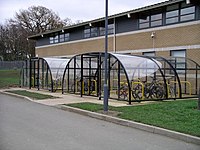Shed
**1. Shed Etymology and Terminology:**
– Recorded in English since 1481 as ‘shadde,’ possibly a variant of shade
– Word ‘shade’ originates from Old English word ‘sceadu’ meaning shade, shadow, darkness
– Old Teutonic/Anglo-Saxon root word for separation or division led to variations like shadde, shad, or shedde
– Anglo-Saxon word ‘shud,’ meaning cover, may have influenced shed’s development
– First usage in 1481 in a sentence describing a yard with a shed for dogs
– Shed may be called a shack, outhouse, or outbuilding depending on region and use
– Municipal bylaws may regulate shed size, appearance, and distance from principal building
– Sheds classified as accessory buildings in some regulations
**2. Shed Uses and Construction:**
– Agricultural sheds store farm equipment, animals, or hay
– Bike sheds provide shelter for bicycles and riders
– Boat sheds store private boats and related items near water bodies
– Garden sheds house gardening tools, seeds, and supplies
– Railway sheds include engine sheds, goods sheds, and train sheds for railway maintenance and storage
– Small domestic sheds available in kit form for self-assembly
– Different types of small sheds like corner sheds, vertical sheds, horizontal sheds, and tool sheds
– Shelves and hooks maximize storage space in sheds used for tools
– Gambrel-style roof sheds increase loft storage space
– Pent sheds have a single angled roof section for rainwater runoff
**3. Shed Materials and Construction Types:**
– Metal sheds offer strength and resistance but may rust over time
– Wood sheds are easy to modify and customize
– Vinyl-sided sheds blend wood strength with low maintenance
– Pressure-treated sheds do not require further preservative treatment during the guarantee period
– Wood sheds are easier to modify with windows, doors, and shelving
– Vinyl-sided sheds are maintenance-free and durable in all weather conditions
– TPR sheds are stronger and more durable than traditional sheds
**4. Shed Culture and Related Terms:**
– Shed culture is prominent in Australia and New Zealand
– Magazines like ‘The Shed’ cater to shed enthusiasts
– Shed competitions like ‘Shed of the Year’ are popular in the UK
– ‘Men and Sheds’ explores the significance of sheds in male retreat
– Shedworking is a lifestyle guide for shed workers
– Related terms include Anderson shelter, lean-to, and Nissen hut
– Tuff Shed is a notable shed manufacturer
– Shed Builder Magazine focuses on the shed industry
**5. Shed Features and References:**
– Larger sheds are typically made of wood with features like windows, shingled roofs, and electrical outlets
– Provide space for hobbies like gardening, small engine repair, or relaxation
– Shed owners can customize features like siding, trim, dormers, shutters, and benches
– Shed-related media can be found on Wikimedia Commons
– Various online resources provide shed information and guides
– Shed permits and building regulations are important considerations
A shed is typically a simple, single-story roofed structure, often used for storage, for hobbies, or as a workshop, and typically serving as outbuilding, such as in a back garden or on an allotment. Sheds vary considerably in their size and complexity of construction, from simple open-sided ones designed to cover bicycles or garden items to large wood-framed structures with shingled roofs, windows, and electrical outlets. Sheds used on farms or in the industry can be large structures. The main types of shed construction are metal sheathing over a metal frame, plastic sheathing and frame, all-wood construction (the roof may be asphalt shingled or sheathed in tin), and vinyl-sided sheds built over a wooden frame. Small sheds may include a wooden or plastic floor, while more permanent ones may be built on a concrete pad or foundation. Sheds may be lockable to deter theft or entry by children, domestic animals, wildlife, etc.




